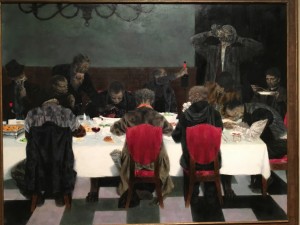
“Supper” 1963-1964
Oil on canvas
Joseph Hirsch American 1910-1981
Columbus Museum of Art
Photo: Mary van Balen
Originally published in The Catholic Times, April 9, 2017
On Saturday, I had the unexpected pleasure of spending a few hours in the Columbus Museum of Art. My sister and I slowly moved from one gallery to another, savoring the opportunity to see the world and explore ideas through the eyes and souls of the artists. They “wake us up” to realities easily overlooked as we hurry through our day to day lives, or challenge us to see the world, others, and even ourselves from broadened perspectives.
A small white sign on the wall of a hallway between two larger exhibits proclaimed: “The Extra Ordinary.” It referred to displayed works made of old bricks, cardboard, and other common objects.
I took a closer look at the row of oil paintings of a water glass. The artist, Peter Dreher, had painted the same glass at different times of day and night for years. “What can change?” you might ask. Light. Reflected images. You’d be surprised what you discover by simply focusing on the lines and beauty of something that usually doesn’t get a second glance. Our lives are filled with opportunities to wonder at the creativity and grace evident in objects made by human hands or that are part of nature. “When was the last time you took a close look and really saw?” the artist seemed to be asking.
A room or two later, I stood in front of a painting by Joseph Hirsch titled “Supper.” Twelve men sitting around a long table, sharing food that included bread and wine immediately suggested the Last Supper. Images of Leonardo da Vinci’s mural of Jesus’ final meal with his apostles might spring to your mind, but this painting is different.
Instead of a white Jesus surrounded by men in flowing robes, twelve homeless men of various colors, unkempt and dressed in shabby jackets and coats, eat hungrily, drinking wine from goblets and lifting food to their mouths with silver forks.
No brightly colored clothing here. The men are dressed mostly in grays, blacks, and browns. The brightest things are on the table. A silver serving dish and coffee pot rest on a white table cloth beside serving bowls heaped with fruit and salad. Obvious at the front of the table sits a goblet of wine and a broken loaf of bread.
The contrast between the poverty of the men and the opulence before them is striking. It spoke to the truth that wealth in our country and the world is held by an increasingly small percentage of people while so many are without food or shelter or hope of finding it. I read the signage to learn when “Supper” was painted. It was finished in 1964. “…at about the same time that President Lyndon B. Johnson enacted laws and reforms known as the War on Poverty, designed to aid disadvantaged American communities.”
I counted the people again. Twelve. “Why didn’t Hirsch include a figure to represent Jesus?” I wondered. Gazing at the image, I slowly became aware of Jesus’ presence. No need to paint him. The Christ was there, dwelling in each of those men.
Before leaving, I read the rest of the sign. It ended by noting “…the relevance to the present day of Christian values of compassion and charity for the poor.” I would say “justice.”
As we move into liturgical celebrations of the Last Supper, Good Friday, and Easter, reflecting on this painting’s message could inform our prayer. In 2017, as in 1964, we examine our response to the call to follow Jesus through death to new life—to share God’s Love given to us.
Do we see that Love shining through creation? Do we see the risen Christ in our sisters and brothers? Do we recognize God dwelling in every human being regardless of color, ethnicity, gender, religious faith or lack of it? Do we share what we have with the poor, the homeless, the immigrants and refugees who live in our neighborhoods and cities and around the globe? Do we foster love and acceptance with our speech as well as actions?
Jesus was God’s face in the world, and it is a face of Love and inclusion, leaving no one out—not Samaritans or gentiles, not women or children. There was no “other.” We walk together in Christ.
©2017 Mary van Balen

Beautiful, relevant thoughts to ponder!
I always love your writings, Mary. Make me “think”.
Thanks for sharing your thoughts on the painting, which is in deed thought-provoking in its many layers.
Just one other comment: The Last Supper was Jesus’ last seder with his disciples, but it wasn’t his “last meal” with them. That was the morning meal shared on shores of the Sea of Galilee, after his resurrection. It was not a dark occasion, but one of dawning light.